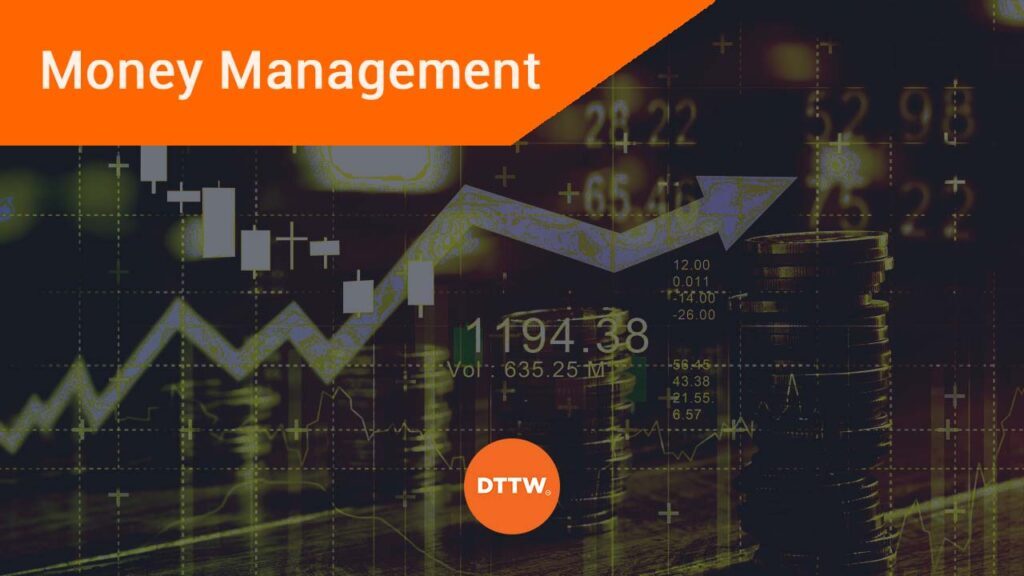Day trading can be a profitable thing to do. At Real Trading, we have seen many successful traders over the years. Still, one certain thing in the market is how risky it is and that you can easily lose money as a trader.
Indeed, in Europe, all companies providing forex brokerage services are required by law to note that most traders lose money, as shown below.
Spread bets and CFDs are complex instruments and come with a high risk of losing money rapidly due to leverage. 71% of retail investor accounts lose money when trading spread bets and CFDs with this provider. You should consider whether you understand how spread bets and CFDs work, and whether you can afford to take the high risk of losing your money. Professional clients can lose more than they deposit. All trading involves risk. – IG.com
In this article, we will look at some of the best money management strategies you should use in day trading.
Table of Contents
What is money management?
Money management is the process of budgeting and using your money well to prevent making serious mistakes. In general, it is a holistic process of maximizing profits and minimizing losses. To a large extent, it is relatively similar to risk management.
Every day trader, regardless of their experience, ought to have quality money management skills. That’s mostly because of the risks involved and the fact that, as a day trader, you will not make similar money in a month.
You can have a streak of five positive months followed by a streak of three negative months. Therefore, having a good money management strategy will help you avoid losing all your money.
Calculating your net worth
The first step in money management is to determine the amount of money you are willing to trade. Most people start with a small amount and then grow it organically. A better approach is to sit down and conduct your net worth. This is a simple process where you add all your assets and subtract with all your liabilities.
Assets include items like: cash in the bank, house, car, and business. Liabilities, instead, include items like loans. Your net worth will be the difference between the two.
Cash Flow Statement
Also, you should do a cash flow statement of your household. This is where you look at the amount of money that you make per month and how you spend it. For example, if you make $10,000 per month and remain with $5,000, you should trade more money than someone who is left with $2,000.
If you have limited resources, you can take the journey of proprietary trading. This is a process where you deposit a small amount of money and then a company gives you funds to trade. If you’re wondering, yes, we are a proprietary trading firm.
A well-tested trading strategy
The next step in money management is to ensure that you have a well-tested trading strategy. Fortunately, there are many strategies that you can use in the financial market.
For example, you can be a scalper, where you focus on buying and selling assets within a short period. Also, you can be a swing trader, where you open a trade and leave it open for a few days or a position trader where you open a trade and hold it for a few weeks or months.
Developing such a strategy takes time. In fact, it is always recommended that you spend months trying and testing to ensure that it works in all market conditions.
Unfortunately, many people starts trading without having a strategy, which leads to significant losses.
Stop loss and take profit
Another money management strategy you should have in trading is having a stop loss and a take profit. A stop loss is a tool that stops a trade automatically when it reaches a key loss level.
For example, if you bought a stock at $10, you can set the stop loss at $8. In this case, if the stock falls to $8, your trade will be stopped automatically.
This will help you ensure that you don’t make more losses when the price drops below $8. A stop-loss can help you avoid substantial losses in periods of high volatility.
Take-Profit Order
A take-profit, on the other hand, is a tool that stops your trades automatically when it reaches a certain level of profitability.
In the example above, you could set the take profit at $13. In this case, your trade will be stopped automatically when it reaches that profit threshold. The take-profit will be implemented whether you are present or not.
Use leverage well
Another important money management strategy in trading is leverage. Most companies will provide you with additional liquidity, in terms of a loan, to help you maximize your profits. This leverage can range from 5 times your initial capital to more than 1,000.
While leverage can be a good thing, it also increases your risk potential. Indeed, it can make you lose more money than what you have in your account.
Therefore, we recommend that you use it sparingly. While a little leverage will not make you a lot of money, it will also help you protect your account.
Final thoughts
There are other methods of managing your money well in trading. For example, you should always avoid adding money into your losses, use a trailing stop, and size your trades well. Using these strategies will help to maximize your profits while reducing risks.
External useful Resources
- 5 Money Management Basic Habits For Financial Success – Navicore Solutions





